ETHMOID: keystone and breath shaper
If ever there was a contest for odd-looking bones, the small ethmoid would be one of the bookie's favourites. However, odd usually means complex and small, easily overlooked in our explorations.
If you have a breathing practice, or are simply interested in exploring your breath more intimately, this irregular, lightweight and spongy bone will add further dimensions to your experience. Don’t forget to have a look at the Field Notes edition that explores the sphenoid bone: finding the wings of the breath, because the ethmoid articulates directly with the body of the sphenoid, manifesting itself as the head of the bird for which I have described the sphenoid as its body, wings and legs.
LOCATION, FORM & FUNCTION
The ethmoid bone is located between our eyes and behind the top of the nose. It forms part of the eye socket, the nasal cavity and the cranial floor. It’s not that big, about 2-3 cm in height, 2.5cm wide and 1-2cm deep, however if you were playing Jenga with your skull and facial bones, you probably wouldn’t want to pull this one out. Articulating with 13 other bones, four cranial and nine facial, it provides structural cohesion for the mid-face and front cranium and as such it has something of the nature of a keystone, which seems appropriate given its location behind the bridge of our nose.
There are four parts to the ethmoid. The first are the ethmoidal labyrinths, which contain multiple air-filled cavities, contributing to the lightness of this very spongy bone. The labyrinths have a rich blood supply, and a mucous lining with a covering of cilia, or tiny hairs. Respectively, these warm, moisten and filtre the air that we breathe. The labyrinths also have two curved bony projections called the superior and middle nasal concha (there is separate inferior nasal concha bone too). These features serve to increase the surface area of the nasal cavity and act as turbinates, from the Greek tyrbē (τύρβη) meaning vortex, dividing and channeling the spiralling air through the nasal cavity.
In contrast with the overall irregular appearance of the ethmoid are two thin, flat structures. The cribiform plate at the top of the ethmoid is horizontal and forms part of the front of the cranial floor that supports the frontal lobe of the brain. It has numerous perforations to allow the passage of olfactory nerve fibres from the nose to the brain. In fact, the overall appearance and filtering functions of the ethmoid is revealed in its etymology from the Greek ēthmos (ἠθμος) meaning sieve. The vertical perpendicular plate extends downward from the cribiform and it forms the upper part of the septum which divides the nasal cavity into right and left halves.
The fourth part of the ethmoid is the crista galli, a small ridge that projects upward from the cribiform. The etymology, from the Latin this time, is spot on with crista meaning crest and galli, from gallus meaning rooster or cockeral. It is an attachment point for an interesting structure called the falx cerebri, a fold in the dura mater, the outer membrane that surrounds the brain and spinal cord, and has a significant role in both separating the two hemispheres of the brain and maintaining stability inside the cranium.


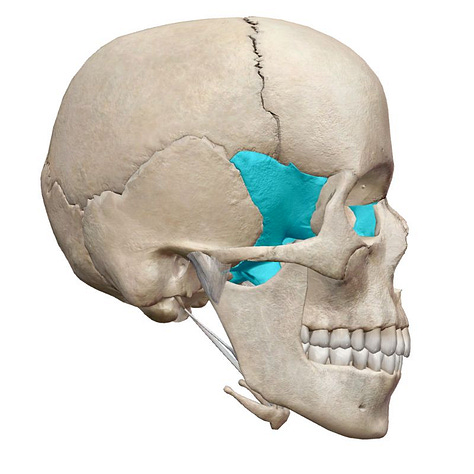
FINDING THE ETHMOID
We can’t directly touch our ethmoid bone but we can locate it by feeling nearby structures. Bring your index-fingertips to either side of your nose and move them up and down to distinguish the softer cartilage from the hardness of the nasal bones. Slide your fingertips upward along the bone until they converge at the apex of your nose. Pause. Your ethmoid is sitting 2-3cm back from here.
We can get closer, but we need to proceed slowly and relatively softly. Let your fingertips move away from each other, and slide them downward into the upper corners of your eyes. You are now in contact with the lacrimal bones which also form part of the eye socket. Your ethmoid again is just a little bit deeper. I understand that this is the location of an acupressure point of the Bladder Meridian, called BL-1, although I think it’s also super close to BL-2. I’m not at all familiar with this map of the body myself, but it’s maybe one that you know, so please share any insights in the comments.
I created some images above in Visible Body to help you locate and visualise this complex little bone together with further images below from Anatomy Standard. Do also check out this 360 video from Anatomy Standard.

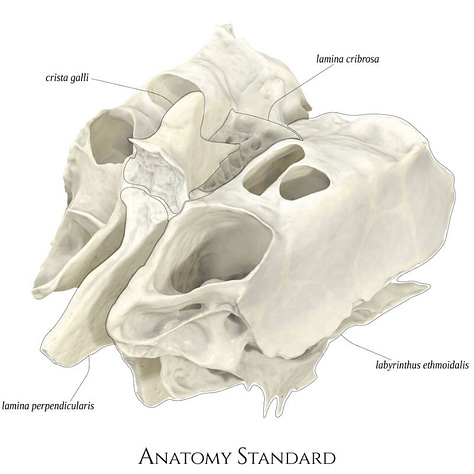
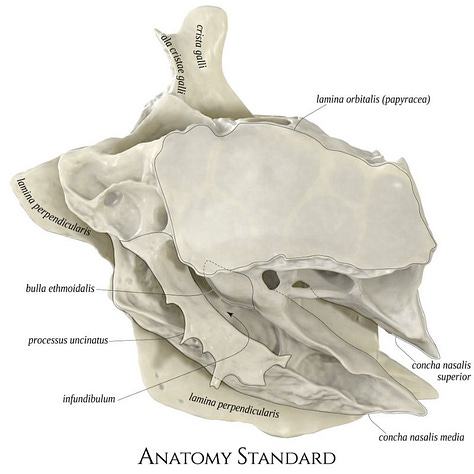
IMAGINE A BIRD OR VENETIAN MASK
Another way to orient towards the ethmoid is to locate the sphenoid bone. As a reminder, place your finger tips against the dip of your temples, just behind the bony part of your eye socket and above your cheek bones. This gives an idea of the “wingspan” of the bird-like sphenoid. Draw your attention to a mid-point between your fingertips and you have landed in the region of the joint between the body of the sphenoid and the ethmoid which, for me, is a lot like finding the the “head” of the bird.
Another image I find helpful is a winged, Venetian mask that I am wearing on the inside, behind my actual face! Try it.

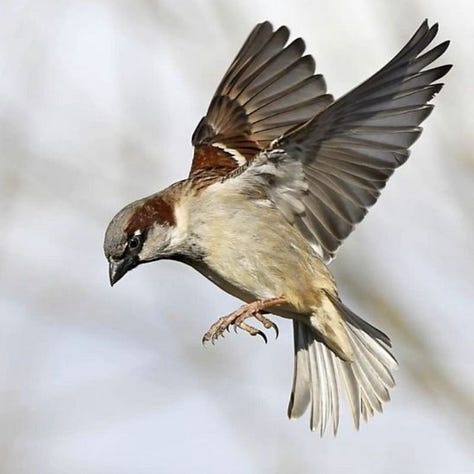
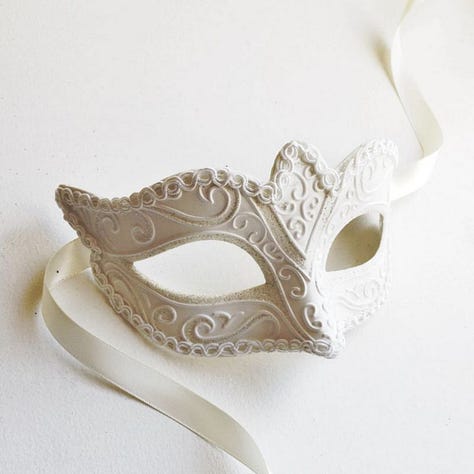
SPIRAL BREATH FLOW
Now you have a good sense of the ethmoid and where it is, let’s explore a few breathing enquiries. (By the wayI’ve recorded some guided practices for the Companion Notes):
Take a few mindful breaths and pay attention to the inside of the nostrils and identify the pathway of the breath. Which surfaces is it touching? Is it running along the sides of the septum, along the midline of your nose? Is it running along the more lateral surfaces away from the midline? Maybe you feel it lifting as it enters the nostrils and running over the roof of the nasal cavity? Explore the possibility that you could intentionally direct the breath over the different surfaces.
Bring to mind that, as the air is drawn into your nose, the conchae act as turbines creating a spiral dynamic in breath. Think about drawing these threads of breath in slowly so that the spirals are not tightly compressed and notice how this acts as a method for lengthening the inhalation.
Think about the pathway of air when you sniff. Notice it when you’re breathing in the aroma of the local bakery or opening a fresh pack of coffee. Scent travels on the breath but makes a very specific journey towards the olfcatory bulbs of your first cranial nerve. Remember the cribiform plate? I’ll explore this more in the Companion Notes.
Finally, bring together the breathing practice of the sphenoid with the ethmoid: as you inhale draw the breath up and back behind the bridge of the nose, towards the head of the bird before letting it spread across the wings. Let the bird fly on the turning of the breath, before it cruises on the exhalation. I love this moving image for my breathing practice and when I see the buzzards in the sky soaring and circling over the nearby fields my breath is in a happy place.
That’s it for now, do let me know if it’s been interesting or helpful to shed light on the ethmoid, and look out for guided practices, more on spirals, and the sense of smell in the follow-up Companion Notes.
Take care until then,
Beverley
I’m hugely grateful for your time in reading Field Notes, please do share this post to friends and colleagues, and I welcome your own insights, comments and questions THANK YOU.


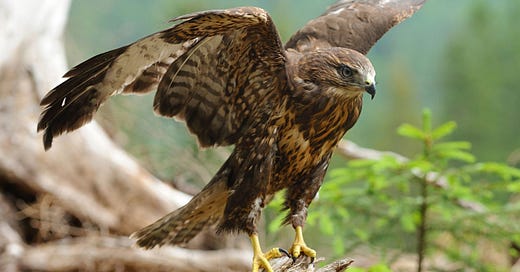



Thank you, Beverly! I love the image of the soaring bird. It adds an entirety new dimension to pranayama.